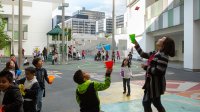Play Will Be More Important Than Ever in Preschool This Year
Play can help the youngest students transition to in-person learning and develop skills they need for the future.
Your content has been saved!
Go to My Saved Content.After a year and a half of social distancing and virtual learning, our transition back to a classroom routine needs to start with social and emotional learning (SEL), and play must be at the forefront in early childhood classrooms. While play has always been an important part of early childhood, teachers should prioritize incorporating intentional play to promote social and emotional development, the very foundation from which we can play and work with others, take turns, manage impulses, and keep trying when we’re struggling.
Play is not only foundational for child development but can also help children process and heal from the impact of living through stress, trauma, or grief, including a global pandemic.
4 Ways to Bring Moments of Play Into the Classroom Every Day
1. Incorporate creative practices: SEL at its best should be interactive and generate moments of connection, discovery, and expression in the classroom. Creative practices like movement, writing, drawing, and music allow students to develop SEL skills in safe, fun, and playful ways. Inspire students to draw how they’re feeling, a favorite memory, or a challenge they’re currently experiencing. Also invite them to communicate how they feel by making a vocal sound or a frozen statue with their bodies, which gives students a simple and quick way to express themselves outside of their thoughts or words.
Creative practices also support academic learning. Early childhood teachers already do this well by teaching through song and incorporating movement, but creativity supports learning for students of all ages. Play should not be restricted to certain grade levels or age groups. Every grade can benefit from getting outside of their head and connecting more to the body. Incorporate micro moments of movement to help ease transitions from one lesson to the next and keep students energized and focused.
Try connecting with classrooms from different grades to provide children of all ages with opportunities to play and interact with other students. This could look like older students leading younger students in games, as if they are the camp counselors facilitating the play with younger students in the community.
2. Create intentional time at the beginning and end of the day to connect through play: The start of the school day is an opportunity for students to ground themselves, shed the distractions and potential stressors from home life, and get ready to learn. Especially for the youngest students, this is a critical time to help them learn how to transition to the school day, a skill that will benefit them throughout their academic careers. Similarly, the end of the day is the perfect time to reflect, reinforce key learnings, and say goodbye as students head back to their families and caregivers.
A great way to start or end the day is with a Shake Off, a brief exercise that involves students shaking their arms, legs, and whole bodies to release whatever tension or stress they’re carrying. Count down from five, shaking the left arm, followed by the right arm, then the left leg, followed by the right leg, and last, the whole body. Repeat and count down from four until you get down to one.
Movement allows students to reset and focus their attention and energy, especially during important times of transition like the start and end of the day. There are more exercises here.
3. Bring playground games into the classroom: Play is not just reserved for recess. Classic playground games like Simon Says; Thumbs Up, 7 Up; or Red Light, Green Light help children learn skills such as how to take turns, plan their next move, and become aware of and control impulses. These games even enrich language skills. Take brain breaks to play interactive games that get students up, moving, and connecting with one another.
Teach these games at the beginning of the year, and play them regularly so that students know what to expect, can transition quickly, and can safely play inside the classroom. Watch how with practice and consistency students better collaborate and support one another in their play.
4. Make multimedia participatory and active: When using multimedia to spark play, keep in mind that not all media has to be about one-way consumption. Videos, podcasts, and audio clips can be interactive and participatory, prompting students to connect with one another, reflect, move around the room, and play. Multimedia resources also allow teachers to participate in play themselves instead of having to facilitate the play, which builds deeper and more authentic teacher-student relationships. Social and emotional learning doesn’t end when the school bell rings, and multimedia resources can help families intentionally and easily support SEL at home, too.
Teachers can find a list of developmentally appropriate podcasts and media for kids in the Apple Podcasts app, curated by Common Sense Education, including podcasts specifically designed to foster SEL.
Social and emotional learning is the foundation for all learning, and play can help us give our students the support they need to move forward. We need to prioritize play in our learning transition efforts in order to foster healing, social and emotional learning, and emotion regulation.
